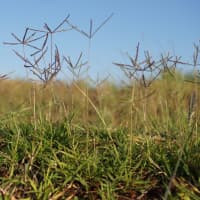Cynodon dactylon is a grass that originated in Africa.
Also known as Vilfa stellata, Bermuda grass, Dhoob, dūrvā grass, dubo, dog’s tooth grass, Bahama grass, devil’s grass, couch grass, Indian doab, arugampul, grama, wiregrass and scutch grass.
Composition
Cynodon dactylon contains various types of phytochemicals such as alkaloids, saponins, phenols, flavonoids, tannins, sterols, glycosides, proteins, amino acids, and carbohydrate.[1]
Phytochemical analysis showed that Cynodon dactylon contain flavonoids, alkaloids, glycosides, terpenoids, triterpenoids, steroids, saponins, tannins, resins, phytosterols, reducing sugars, carbohydrates, proteins, and volatiles and non-volatile oils, and also contain nutrients such as fat, fiber, iron, calcium, phosphorus, potassium and beta-carotene.[1:1]
Healing Properties
Anti-Allergic
Anticancer
Every year, several secondary metabolites are extracted from the plants and used as new sources for the treatment of various cancers.[1:2]
Antimicrobial
Anti-Bacterial
Anti-Viral (antiviral)
Anticoagulant
Antioxidant
High antiradical activity was found for the stem extract of the plant.[1:3]
Antiinflammatory
Antimalaria
Anti-Pain
Antilithiatic
Prevents the formation of, or relieves the symptoms of kidney stones.
Antilithiatic potential Cynodon dactylon.[2]
CaOx crystal dissolution and crystal growth inhibition properties.[2:1]
Disease / Symptom Treatment
Diarrhea
Diabetes
Dental caries
Fever
Wound Healing
Hypertension
Kidney Stones**
Title: Phytochemical studies of Cynodon dactylon (L.) and isolation and characterization of bis(2-ethylheptyl) phthalate from the plant
Publication: Asian Journal of Green Chemistry
Date: October 2020
Study Type: Original Research Article: Phyto-chemical analysis
Author(s): Ali Allahresani, Fatemeh Ghorbanian, Milad Kazemnejadi, Mohammad Ali Nasseri
Institution(s): Department of Chemistry, College of Sciences, University of Birjand, P. O. Box 97175615, Birjand, Iran
Abstract: In this study, the phylum Cynodon dactylon was assessed phyto-chemically. The results revealed that the plant had a rich source of phytochemicals as the root of this plant contains 830.27 mg/kg of carbohydrate. Also, 2.5 mg/g phenolic compounds were found in the ethanolic extract of the plant. Fatty acid composition of the plant as also investigated, wherein palmitic acid and linoleic acid had the highest contents in aerial parts of C. dactylon with 37.63% and 30.45%, respectively. In addition, high antiradical activity was found for the stem extract of the plant. Finally, bis(2-ethylheptyl) phthalate as an anti-oxidant and anticancer compound was extracted from the C. dactylon plant stem extract and fully identified and characterized using the FT-IR, CHN, 1H NMR, 13C NMR analysis along with various 2D NMR techniques.
Copy: archive, archive-mirror
- ↩︎ ↩︎ ↩︎ ↩︎
Title: In vitro antilithiatic potential of Kalanchoe pinnata, Emblica officinalis, Bambusa nutans, and Cynodon dactylon
Author(s): Atul K Sohgaura, Papiya Bigoniya, B Shrivastava
Institution(s): School of Pharmaceutical Sciences, Jaipur National University, Jaipur, Rajasthan, India, Dr. Satyendra Kumar Memorial (DKSM) College of Pharmacy, Ram Krishna Dharmarth Foundation (RKDF) University, Bhopal, Madhya Pradesh, India
Publication: Journal of Pharmacy & BioAllied Sciences
Date: 4-Jun-2018
Abstract: Objective: The study aims at the exploration of calcium oxalate (CaOx) crystal growth inhibition potential of Cynodon dactylon, Emblica officinalis, Kalanchoe pinnata, and Bambusa nutans ethyl acetate fraction rich in polyphenol and flavonoid. Materials and Methods: Ethyl acetate fraction was separated from the hydromethanolic extract of C. dactylon, E. officinalis, K. pinnata, and B. nutans followed by quantitative analysis for total polyphenol and flavonoid content. Ethyl acetate fraction of all the plants were subjected to in vitro screening for the inhibition of CaOx crystals growth induced by sodium oxalate. Results: The results signify rich presence of polyphenols and flavonoids in K. pinnata and E. officinalis ethyl acetate fractions followed by C. dactylon and B. nutans. Ethyl acetate fractions of B. nutans shoot, E. officinalis fruit, and K. pinnata leaf have excellent in vitro CaOx crystal growth inhibition potential based on both the comparative concentration and the time level to achieve IC50. Conclusion: The study outcome substantiates potential in vitro CaOx crystal dissolution and crystal growth inhibition properties of E. officinalis, B. nutans, C. dactylon, and K. pinnata. Rich presence of caffeic acid, ferulic acid, and luteolin in ethyl acetate fraction of B. nutans leaf, and chebulinic acid, chebulagic acid, gallic acid, ellagic acid, and quercetin of E. officinalis may have produced prominent crystal aggregation inhibition response.
Link: http://www.jpbsonline.org/article.asp?issn=0975-7406;year=2018;volume=10;issue=2;spage=83;epage=89;aulast=Sohgaura
Citations: ↩︎ ↩︎
